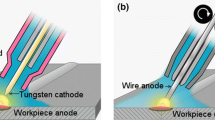Abstract
Recently, it has become necessary to control or reduce weld distortion, which has a negative influence on structural integrity, without loss of manufacturing efficiency. Some studies on the fundamental characteristics of weld distortion and its control or reduction have been conducted. However, the results cannot be applied to all welding processes because such processes are becoming more diversified. For this reason, to understand the fundamental characteristics of weld distortion based on the welding conditions, the heat transport phenomenon in arc physics must be investigated. In this study, an experiment and numerical simulations are conducted to investigate the link between arc physics and weld distortion. As a result, the relation between weld distortion and the heat transport phenomenon is further clarified.
Similar content being viewed by others
References
Satoh K. and Terasaki T.: Effect of welding conditions on welding deformations in welded structural materials, Journal of the Japan Welding Society, 1976, vol. 45, no. 4, pp. 302–308 (in Japanese).
Rosenthal D.: Mathematical theory of heat distribution during welding and cutting, Welding Journal, 1941, vol. 20, no. 5, pp. 220–234.
Tanaka M. and Lowke J.J.: Prediction of weld pool profiles using plasma analysis, Journal of Physics D: Applied Physics, 2007, vol. 40, no. 1, pp. R1–R23.
Tashiro S., Tanaka M., Nakata K., Iwao T., Koshiishi F., Suzuki K. and K. Yamazaki: Plasma properties of helium gas tungsten arc with metal vapor, Science and Technology of Welding & Joining, 2007, vol. 12, no. 3, pp. 202–207.
Tashiro S., Tanaka M., Nakatani M., Furubayashi M. and Yamazaki Y.: Properties of mass and heat transfer for tube cathode arcs, Quarterly Journal of the Japan Welding Society, 2007, vol. 25, no. 1, pp. 3–9 (in Japanese)
Okano S., Mochizuki M. and Toyoda M.: Angular distortion reduction by in-process control welding using back heating source, Materials Science Forum, 2007, vols. 580-582, pp. 577–580.
Author information
Authors and Affiliations
Corresponding author
Rights and permissions
About this article
Cite this article
Okano, S., Mochizuki, M., Yamamoto, K. et al. An attempt to enhance NUMERICAL MODELS OF ANGULAR DISTORTION by considering the physics of the welding arc. Weld World 55, 93–100 (2011). https://doi.org/10.1007/BF03321299
Published:
Issue Date:
DOI: https://doi.org/10.1007/BF03321299




